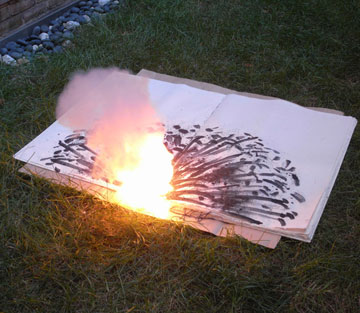
The Victoria and Albert Museum’s latest exhibition, Blood on Paper: The Art of The Book, showcases book-based work by a wealth of modern and contemporary artists, including Cai Guo-Qiang and Richard Tuttle (Season 3) and Louise Bourgeois (Season 1).
Since the book form implies a beginning, middle and end, it’s always been a popular form for artists looking to meddle with heads, from Max Ernst’s superlative The Hundred Headless Woman onwards. The exhibition traces a significant transformation in the definition of the artist’s book: from a kind of freeform improvisation on textual illustration (Matisse’s Jazz, Sol LeWitt’s take on Borges’ Ficciones) to an artwork taking the form of a book as its conceptual jumping-off point (Dieter Roth and Richard Hamilton’s Inter Faces and Richard Tuttle’s NotThePoint). The connotations of books as cornerstones of religious doctrine are underscored by Damien Hirst’s New Religion, a huge, plinth-mounted mixed-media sculpture in the form of a shelved Bible, set off by a display of Francis Bacon’s much-pored-over ephemera, battered Muybridge photos and snaggly Polaroids, displayed in glass like the fingerbones of a saint.
The most fun is to be had in the illumination artists’ work can cast on a canonical text; Balthus replays Wuthering Heights as a pas de deux of feral adolesence; Paula Rego turns Jane Eyre into a mad psychodrama of Gothic puppetry. Serialism found an easy home in the book form, with Ed Ruscha’s deadpan series of swimming pools and gas stations repeated on every page of a pocketsize book, insouciance itself. Meanwhile, the pages of Cai Guo-Qiang’s Danger Books, charred with the spidery remainders of fireworks, indicate the book as a site of explosive excitement, and anyone who’s ever been 7 will probably agree.



